
Brampton’s diversity not reflected at city hall; audit shows only 37% of employees are visible minorities
Brampton’s diversity is consistently championed by municipal politicians as one of the city’s biggest strengths.
“The @CityofBrampton is proud of our multicultural mosaic,” tweeted Mayor Patrick Brown, announcing one of the city’s streets being named for Guru Nanak, the founder of Sikhism.
“In Brampton we celebrate our minorities, our diverse communities and all of their contributions,” tweeted Councillor Gurpreet Dhillon.
“Brampton is blessed with diversity and culture,” tweeted Councillor Rowena Santos.


This is indeed something to be celebrated, as the city’s visible minority population has grown rapidly over the last three decades to almost 74 percent of the city’s 600,000-plus population. This range of cultures, religions, races and beliefs brings with it different mindsets, skills and abilities, all of which can improve Brampton both socially and economically.
So why isn’t the City of Brampton taking advantage?
A recent audit has found that only 37 percent of the city’s workforce identify as racialized, and less so for those in senior positions, only 15 percent of the city’s Corporate Leadership Team (CLT) are racialized individuals, although there has been large turnover within the CLT since the start of the assessment. The numbers raise the potential that top City of Brampton officials are unable to understand the issues facing both their racialized staff members and the citizens of Brampton, the people they are hired to serve.
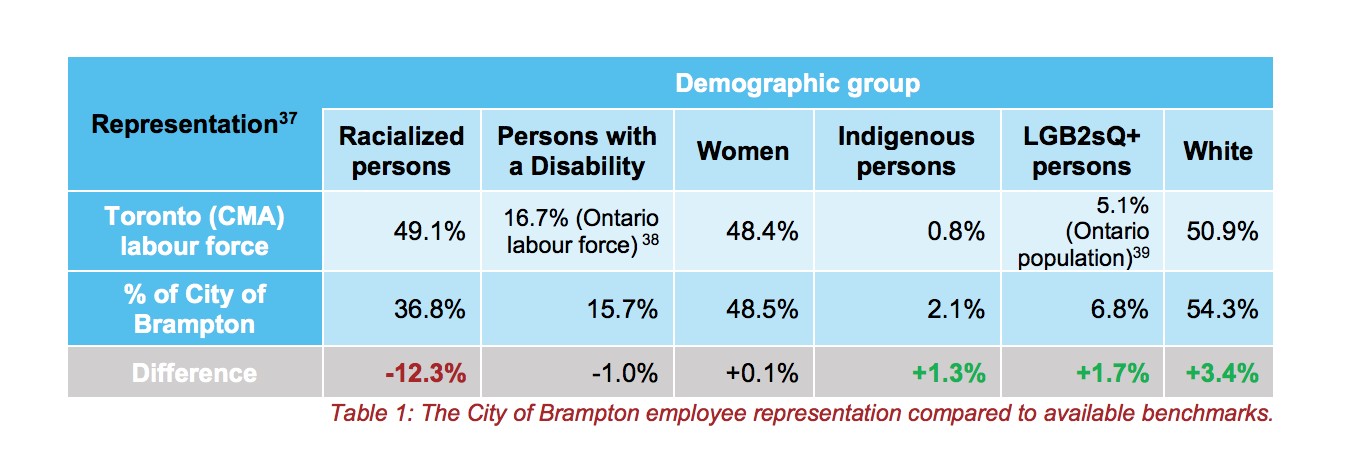
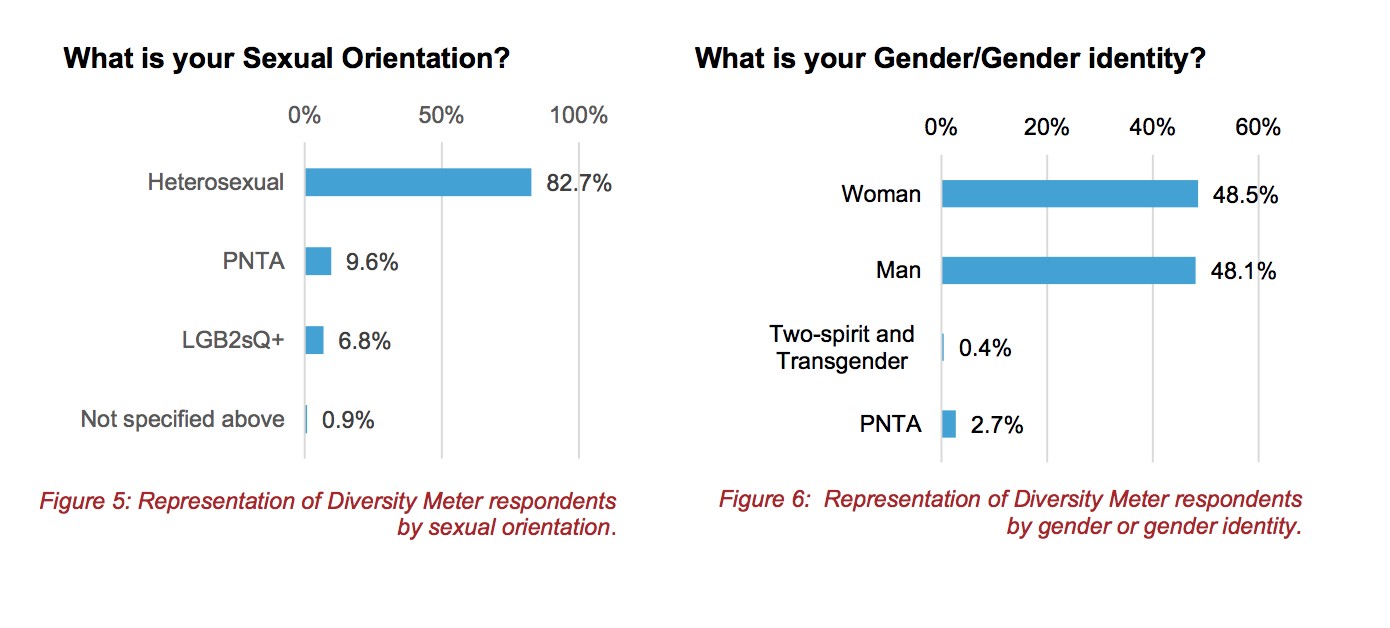
The Canadian Centre for Diversity and Inclusion (CCDI), who completed the audit, also notes that a lack of concern surrounding barriers to diversity and inclusion can manifest in serious issues for a corporation, including creating a disengaged workforce and leading to lack of productivity — something that is currently a concern inside and outside city hall.
“The City has a goal to grow a workforce reflective of the community it serves,” reads a statement from the city. “The City will review the recruitment and advancement process for barriers, biases and/or unintended inequities, integrate diversity and inclusion practices, develop diversity outreach goals and enhance learning and a greater awareness of bias.”
It must be said that these findings are not isolated to the corporation of the City of Brampton. Most recently the Peel Regional Police had a similar, more in-depth, audit completed of its organization that found similar issues, and the turmoil ongoing at the Peel District School Board (PDSB) is being blamed on an alleged lack of equity in the board that has allowed anti-Black and other forms of racism to flourish.
With Brampton’s quickly growing population — expanding from 521,315 in 2011 to 603,346 in 2017 — and the fact that the city is one of the most popular places for new immigrants to settle, makes it difficult for corporations to keep up with the rapid demographic changes.
However, CCDI also identified significant issues that exist within the corporation that could hinder the city’s ability to move forward in hiring a more diverse workforce, including senior leaders and managers who don’t believe significant barriers exist within the organization — despite a large proportion of lower-level staff saying these barriers do exist — and senior leaders believing the city is much further along in terms of their efforts on diversity and inclusion than they really are.
“These findings suggest that the CLT (corporate leadership team) members are not demonstrating awareness of workplace issues that are likely to be negatively impacting the city’s inclusion climate,” the audit reads. “These findings are also indicative the CLT lacks a satisfactory understanding of structural barriers.”
One significant exception is in the mayor’s office. Mayor Patrick Brown, before the current council knew about the audit, hired a staff that is overwhelmingly racialized, with eight of his ten employees (including one part-time staffer) being visible minorities.
Brown’s most senior staff, including Babu Naglignam, his chief of staff, Frances Bradshaw, his director of operations and Urz Heer, head of government affairs, are all visible minorities.

Brampton Mayor Patrick Brown
“My team wasn’t built to be diverse,” Brown told The Pointer. “It is reflective of the City because the members I hired were the most talented and competent individuals who applied.”
Brown believes hiring, if done fairly, should naturally reflect the community.
“There is no shortage of capable individuals within our cultural mosaic of Brampton. They just need to be given the opportunity to compete and when they do they shine. Your Brampton mayor’s office isn’t an old boys club but sadly too many government offices are.”
The mayor, the top boss in the city, says under his leadership he’s committed to reflecting what he sees in the community. “In Brampton, we take pride in doing things differently. It’s in my DNA to believe in the strength of our mosaic.”
As part of the CCDI survey, staff were provided with a list of statements, of which they had to respond with “agree”, “disagree”, “neutral” or “PNTA” (prefer not to answer).
The difference in opinion is most stark when placing the responses of senior leaders in the corporation against lower level staff members, with the level of agreement to certain statements differing at times by as many as 20 percentage points.
For example, when faced with the statement: “At The City of Brampton, I feel inspired to behave more inclusively,” 82.5 percent of senior leaders agreed, while 71 percent of supervisors and managers agreed, 62 percent of team leads and only 57 percent of low level staff.
A similar trend can be seen with statements like: “I trust that, if I raise an issue related to diversity or inclusion, my manager/supervisor will take action,” where 89 percent of senior leaders agree, but only 60 percent of other staff see things the same way, and with the statement, “I am able to be myself at work,” 86 percent of senior leaders agree compared to 64 percent of lower level staff.
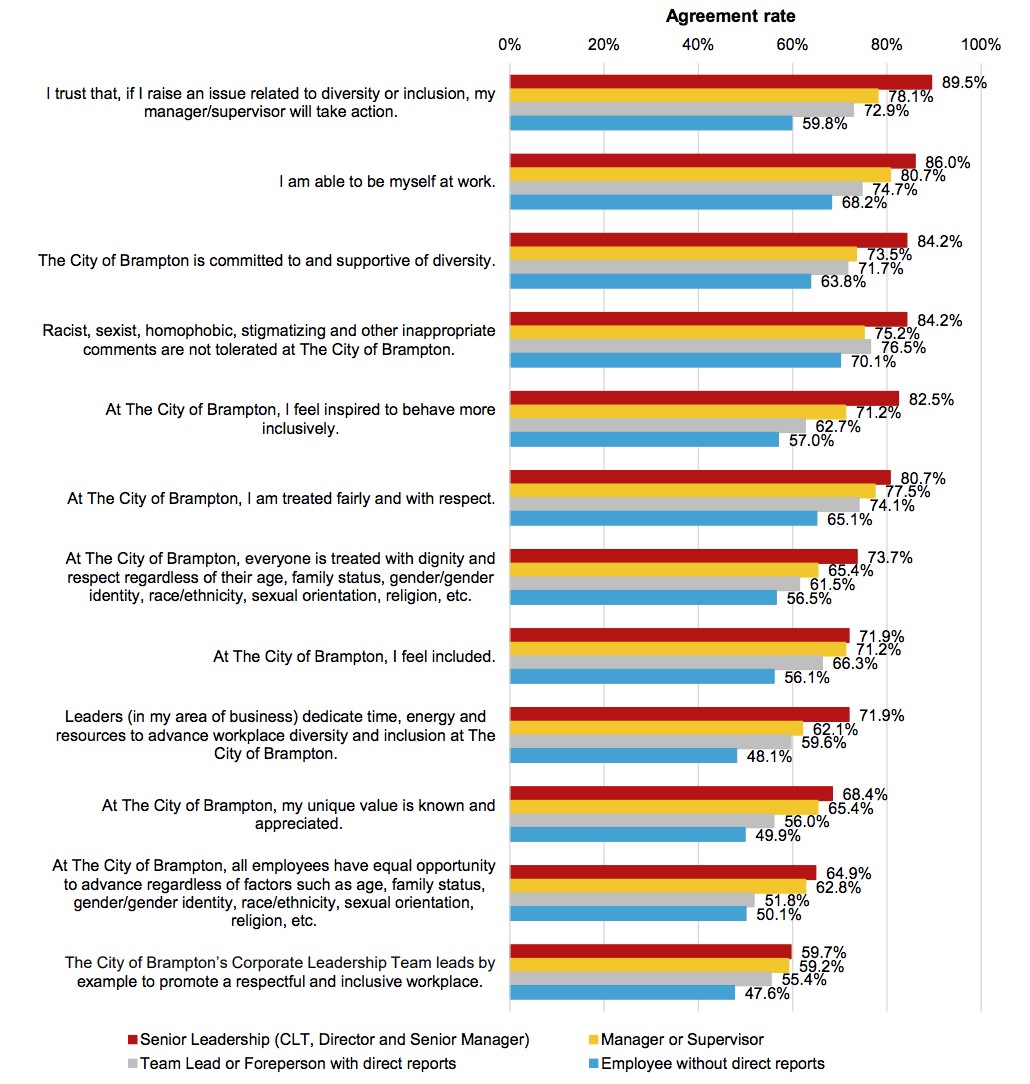
These differences grow even more pronounced when comparing responses of heterosexual, white, male staff members without disabilities and staff members who identify as racialized, female, indigenous or LGBTQ.
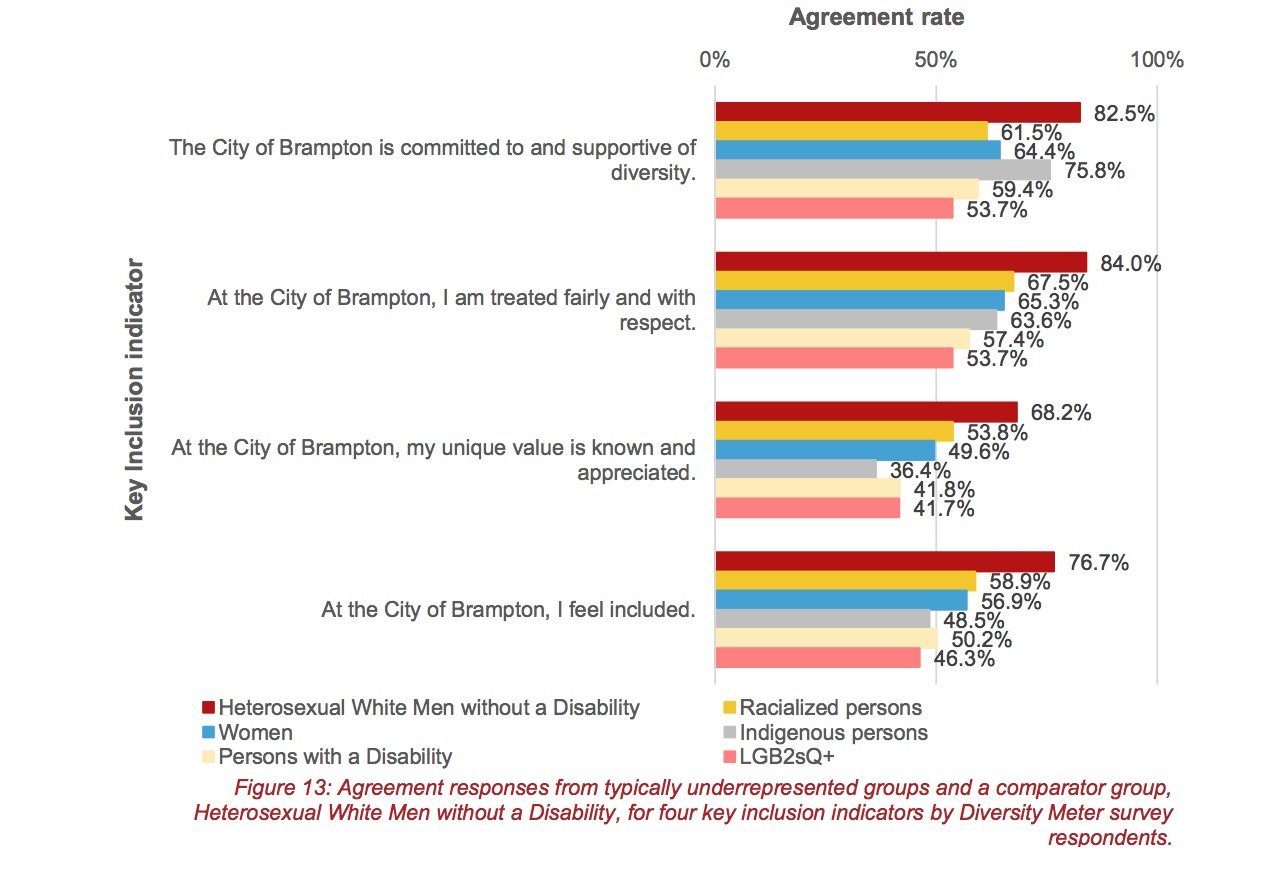
According to CCDI, the audit involved “extensive data collection” including a review of city policies, a workforce census and inclusion survey, focus groups with staff, as well as interviews and cultural competence assessments with the CLT. Less than one third of the city’s workforce responded to the CCDI survey, which reflects poorly on the organization as this is seen as an indicator that the corporation is not taking the issue seriously. Only 1,587 of the city’s 5,525 staff responded to the survey. Organizations that take equity and inclusion seriously, shown in their actions not just their words, ensure that as many as 90 percent of employees participate in such surveys. The city’s failure to get more buy-in, with only about 29 percent of staff responding to the survey is one of the clearest indications that the senior executives and managers don’t take equity and inclusion seriously, as it was their responsibility to ensure full buy-in with the survey.
CCDI has stated that survey participation rates in its audits reflect on an organization’s values. If the City of Brampton had done a better job of ensuring employees participated in the survey, it’s possible that the results could have shown even larger gaps in hiring and even more troubling attitudes around equity and diversity.
According to city staff, the City began employee communications about the survey in January 2019.
“Awareness activities included posters, intranet and email messages, leadership support, and in-person information sessions. Participation was voluntary, and the online survey was open from January 30, 2019 to March 1, 2019,” reads a response from the city to a list of questions from The Pointer.
The potential lack of awareness about the audit was already raised by councillors this past July when it came as a surprise to them that the city had contracted CCDI to assist with the study.
“It caught us off-guard,” Councillor Martin Medeiros said at the time.
Similar concern was raised by Councillor Dhillon, who said council wasn’t properly informed about the audit, an indication that senior staff didn’t take it seriously. He also took issue with the cost of contracting CCDI to complete the assessment ($90,000) and the limited scope of the audit. Additionally, council learned the results of the audit were already 15 months overdue, initially scheduled for completion in March of 2018.
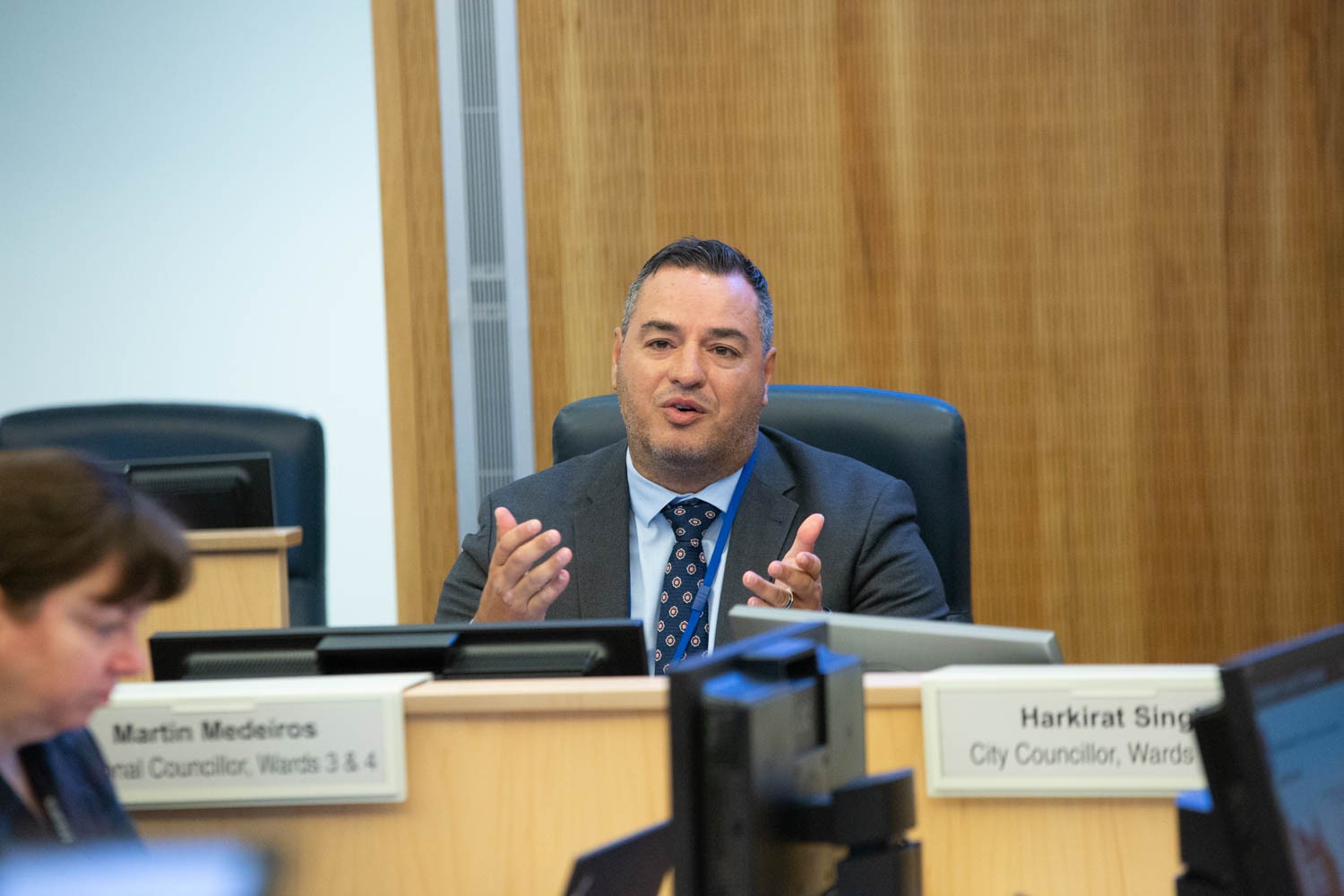
Councillor Martin Medeiros
Despite only being elected in October of last year, council’s lack of awareness around the ongoing audit signals a failure of staff to make those inside city hall aware of the audit work including its crucial survey.
However, for those who did respond, they generally rated the city’s leadership very poorly when it came to thoughts around inclusion efforts.
Overall, CCDI states employees “indicated low perceptions of inclusive leadership and management and concerns about leadership’s understanding, commitment and support of diversity and inclusion.”
In particular, when posed with the statement, “City of Brampton’s Corporate Leadership Team leads by example to promote a respectful and inclusive workplace,” only 51 percent of respondents agreed, 30 percent were neutral and 13 percent flat out disagreed.
Additionally, when posed with: “At The City of Brampton, all employees have equal opportunity to advance regardless of factors such as age, family status, gender/gender identity, race/ethnicity, sexual orientation, religion, etc,” 15 percent of respondents disagreed, 53 percent agreed and 25 percent remained neutral.
CCDI also heard concerns from employees about nepotism and bias in the hiring process, a lack of recognition, support and accommodation, and inconsistent opportunities for training and development.
Some survey respondents also noted that issues of harassment and discrimination permeated many levels of city hall, including senior staff and council.
One anonymous respondent said members of council have made inappropriate remarks, but it’s unclear if this was a reference to current or former council members.
“There are some very traditional mindsets around gender even though we are evolving,” noted another.
The survey found that 38 percent of Brampton staff admit to experiencing harassment or discrimination at work, and 57 percent of respondents acknowledged witnessing discrimination or harassment.
“The results from the leader interviews and the focus groups demonstrate that a lack of knowledge and experience of harassment on the part of leaders may result in negative perceptions (e.g. mistrust, low confidence) from employees,” the audit reads. “Mistrust and/or low confidence from employees can negatively impact employees’ willingness to report incidents – the consequence is a negative impact on the inclusion climate at an organization.”
Staff also noted that senior leaders and human resources were reluctant to address these issues.
When posed with the statement, “If I were to report a concern about inappropriate behaviour to my manager or HR, I am confident that it would be handled effectively,” only 33 percent agreed, 43 percent remained neutral and 24 percent disagreed.
“There is a notable misalignment between the CLT and employees’ perception of fairness,” the audit reads.
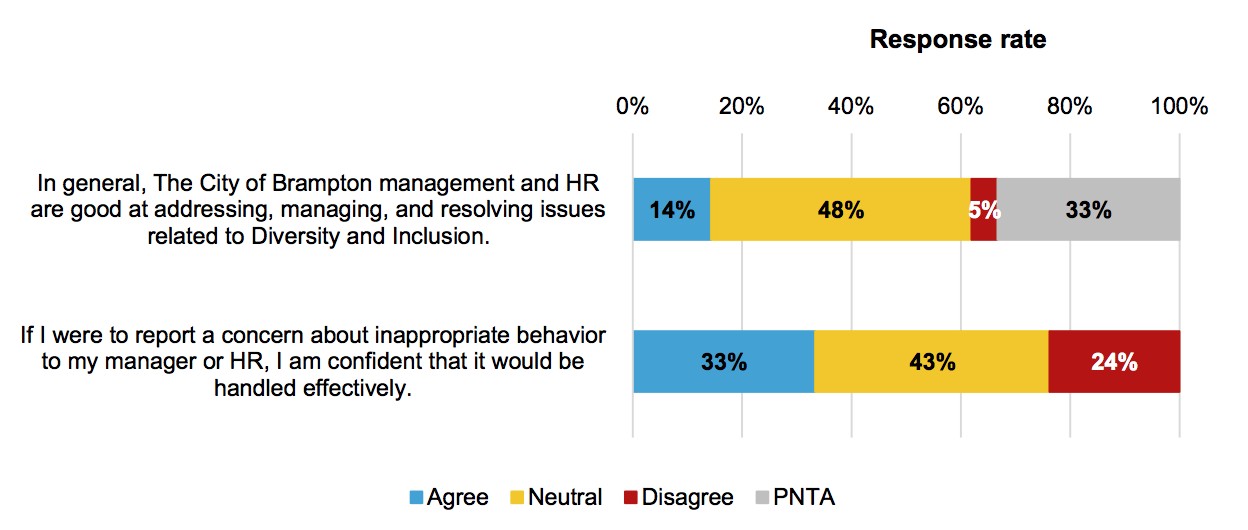
This fault for this disconnect lies with what CCDI describes as a “minimization” mindset among the CLT. Approximately 46 percent of city leaders operate from a mindset that “overemphasizes similarities instead of acknowledging and valuing differences.”
“According to CCDI, [their] assessment tool shows that the minimization mindset among leaders is consistent with findings from organizations worldwide,” the city states. “Now that CCDI has helped to identify this finding, the Strategic Leadership team is committed to take action quickly and implement important changes identified in the work plan and within their individual assessments.”
This is not to say it was all bad news for the City of Brampton. The audit points out that as of July 2018, 23 percent of the CLT were making decisions from what CCDI describes as an “acceptance” mindset, or making decisions with cultural competency in mind. As well, the city was praised for having diversity and inclusion integrated into the city’s business strategy.
Yet, even these accomplishments highlighted just how far the city still has to go.
As CCDI points out, the city has made efforts in the diversity and inclusion sector by implementing elements into its business strategy. However, it points out that these initiatives are typically “isolated” and “disconnected from the overarching organizational vision.”
As part of CCDI’s work, there is an extensive list of recommendations and a timeline for implementation. According to staff, a report is set to be included on council’s agenda for its Dec. 4 meeting. That agenda will be released on Friday.
The CCDI recommendations include creating a position solely dedicated to implementing a diversity and inclusion strategy (something city staff confirm Brampton currently does not have, even though many organizations in Ontario created such a position years ago), establishing a corporate (staff) diversity and inclusion committee — a previous council iteration of this type of committee was plagued with issues — and tasks for improving job postings and policies to make the city more welcoming and open to diverse job candidates.
In a statement released Wednesday, Mayor Brown says he plans to bring forward a motion at next week’s council meeting to have the city accept all of the recommendations made in the audit. A similar motion was put forward by Brown at the Peel Police Services Board following its audit.
“If you do the report but don’t take the recommendations, then it’s just a PR exercise,” Brown told The Pointer.
A press release from the city states that following the results of the audit, the city has developed a five year Workplace Diversity and Inclusion Strategy, and a work plan that sets out the tasks to be carried out moving forward.
“A workplace strategy of this type directly impacts the community,” the city states. “Leading public sector organizations like Brampton know that an increase in inclusion means an increase in employee engagement. In turn, employee engagement affects productivity and customer service – and efficient, effective delivery of services creates trust and confidence among residents, businesses and stakeholders.”
Email: [email protected]
Twitter: @JoeljWittnebel
Submit a correction about this story


